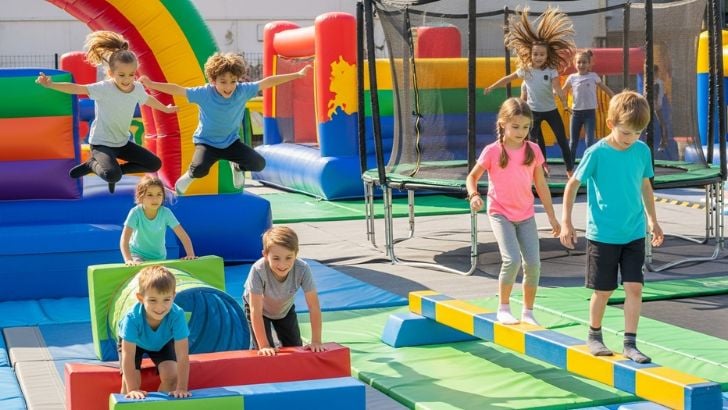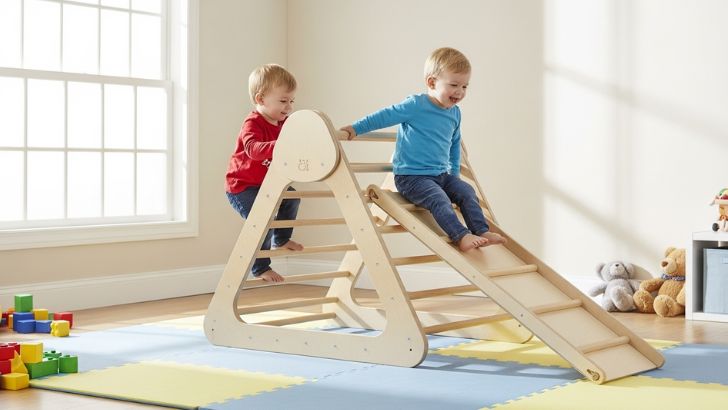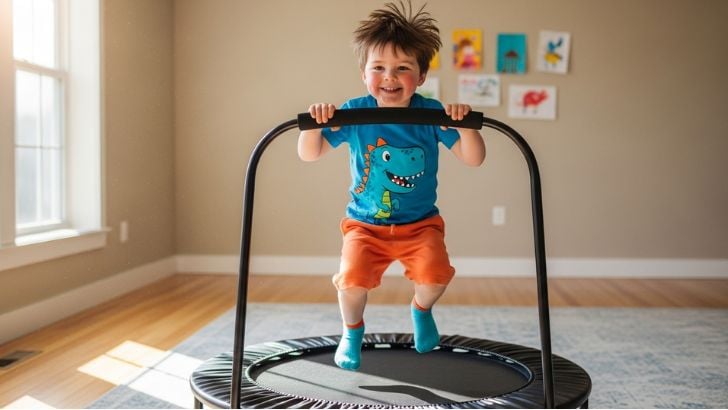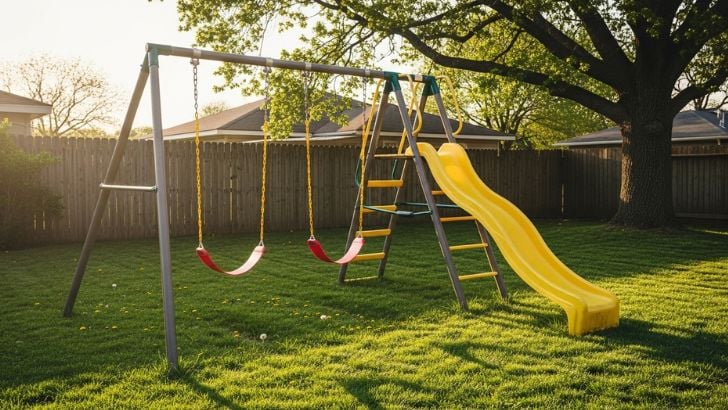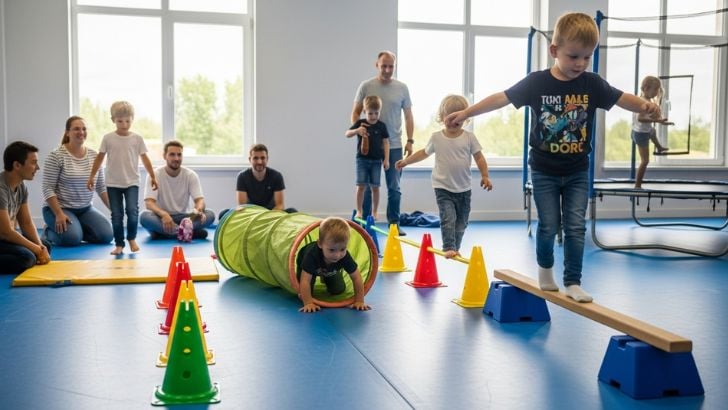Watching your child grow through play is amazing. Active play is key for kids’ growth and the right gross motor toys can make a big difference.
Gross motor skills are vital for kids. The right toys can help them stay active and have fun.
1. Building Strength and Fun Through Play
I’ve seen how the right toys can change playtime. They help kids get stronger and better at balancing. Toys like balance beams and ride-on toys are key in this process.
Gross motor skills help kids do everyday things easily. Playing helps kids run, jump, and balance better. It lets them explore, try new things, and feel confident.
Gross motor play is good for many things. It makes kids healthier and smarter. For example, balance beams help kids focus. Ride-on toys spark imagination and help kids play with others.
| Gross Motor Toy | Primary Benefit | Age Group |
| Balance Beams | Improves balance and coordination | 3-6 years |
| Ride-On Toys | Enhances leg strength and mobility | 2-5 years |
| Climbing Structures | Develops upper body strength and agility | 3-7 years |
We’ll look closer at gross motor toys next. We’ll talk about their benefits and how to pick the best ones for your child. Knowing the value of gross motor play helps parents choose toys that are both fun and educational.
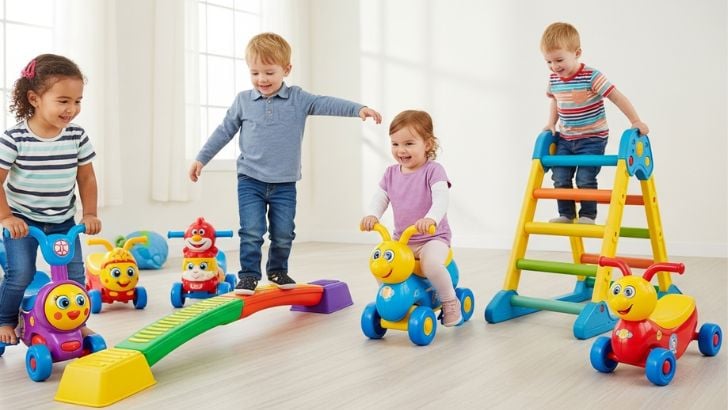
2. What Are Gross Motor Toys?
Gross motor toys are key for a child’s growth. They boost physical activity and coordination. These toys help kids learn to run, jump, throw, and balance.
As a parent, knowing about gross motor toys is important. It helps you pick the right toys for your child.
So, what are gross motor toys? They make kids move and be active. Push and pull toys like toy lawn mowers or shopping carts are good. They assist children in becoming more agile and stronger.
Sports gear for kids like mini soccer goals or basketball hoops are also great. They help kids learn team sports and stay active.
Ride-on toys, like tricycles or scooters, help with balance and leg strength. Climbing structures and activity gyms are also great. They help kids get fit and improve their gross motor skills.
Using gross motor toys in playtime is good for kids. It makes them more active and helps with coordination and balance. These toys are vital for kids to grow well.
Related: STEM Toys for 4 Year Olds | Educational Toys for 8 Year Olds | Snow Toys for Kids | Toys for Preschoolers | Glow in the Dark Toys | Cool Toys that Dance | Cool Toys that Change Color in Water
3. Benefits of Gross Motor Play
Gross motor play is great for kids. It makes them stronger, better at moving, and happier. Fun activities like inflatable bounce houses and trampolines are key for their growth.
Playing helps kids stay healthy. It makes their bones and muscles strong. It also improves their heart health and flexibility. For example, trampolines help bones get denser, and bounce houses keep hearts active.
These activities also help with balance and coordination. Kids learn to move better in space. You see this in activities like obstacle courses with bounce houses.
Play also helps kids feel better mentally. It reduces stress and anxiety by letting kids release energy. Plus, it helps them work better with others, like in team games.
To show the benefits, let’s look at some examples:
| Activity | Physical Benefits | Psychological Benefits |
| Trampolining | Improves bone density, enhances cardiovascular fitness | Reduces stress, improves mood |
| Inflatable Bounce Houses | Enhances cardiovascular fitness, improves coordination | Promotes social interaction, reduces anxiety |
| Balance Beams | Improves balance, enhances muscle strength | Boosts confidence, improves focus |
In short, gross motor play is very important for kids. Activities like trampolining and bounce houses help them grow physically and mentally. Parents can make a big difference by adding these to their kids’ lives.
4. Types of Gross Motor Toys Parents Should Know
Gross motor toys are more than fun. They help build strength, coordination, and agility in kids. Knowing the different types helps you choose the best for your child’s playtime.
Climbing Structures & Activity Gyms
Climbing structures and activity gyms boost strength, flexibility, and problem-solving. They come in many forms, like indoor climbing triangles and outdoor play gyms.
- Indoor Climbing Triangles: Great for indoor play, these triangles build upper body strength and coordination.
- Outdoor Play Gyms: Bigger and more complex, outdoor gyms offer climbing, swinging, and balancing activities.
Ride-On Toys & Push and Pull Toys
Ride-on toys and push/pull toys improve balance and coordination. They encourage active play and strengthen legs.
- Ride-On Scooters: These toys help with balance and coordination while being fun to ride.
- Push and Pull Toys: Wooden carts or animals on wheels improve strength and coordination as kids push or pull them.
Balance Beams
Balance beams enhance balance and coordination. They vary in width and height, fitting different ages and skill levels.
- Foam Balance Beams: Soft and safe, foam beams are great for young kids or beginners.
- Wooden Balance Beams: Challenging, wooden beams are best for older kids or those more experienced.
Swing Sets & Bouncy Castles
Swing sets and bouncy castles are fun for developing gross motor skills. They promote active play and social interaction for your kids.
- Swing Sets: Classic outdoor toys, swing sets improve leg strength and coordination.
- Bouncy Castles: Inflatable and fun, bouncy castles are great for parties or playdates, encouraging active play and laughter.
| Toy Type | Age Range | Benefits |
| Climbing Structures | 2-8 years | Strength, flexibility, problem-solving |
| Ride-On Toys | 1-6 years | Balance, coordination, leg strength |
| Balance Beams | 3-10 years | Balance, coordination, focus |
| Swing Sets | 2-12 years | Leg strength, coordination, social interaction |
5. Top 12 Best Gross Motor Toys for Kids
Gross motor skills are all about using big muscles for big movements – running, jumping, climbing, and balancing! These skills are super important for kids’ health, coordination, and confidence. In 2025, the best gross motor toys help kids use energy, learn about their bodies, and build strength, balance, and agility. Whether you’re looking for outdoor gross motor toys for sunny days or indoor gross motor toys for rainy ones, this list has you covered!
1. Indoor Climbing Triangle with Ramp
- Features: A strong wooden or plastic frame shaped like a triangle. It often has rungs for climbing and a removable ramp. Your kids can use the ramp for sliding or climbing.
- Benefits: Encourages climbing, sliding, and spatial awareness. Helps develop upper body strength, coordination, and confidence in navigating obstacles.
- Recommended Age: 1-5 years old (Perfect as a toddler-friendly climbing toy).
- Pros: Great for indoor gross motor toys, folds for storage, durable, multi-functional.
- Cons: Can be a bit pricey, requires floor space when in use.
2. Foam Balance Beam
- Features: Soft, lightweight foam segments that connect to form a low-to-the-ground balance beam.
- Benefits: Safely introduces children to balancing activities, improving core strength, coordination, and proprioception (awareness of body in space).
- Recommended Age: 2-6 years old.
- Pros: Its soft material and low height ensure safety. You can easily set up and store it, and you can use it as an indoor gross motor toy.
- Cons: Can slip on very smooth floors without a non-slip mat underneath.
3. Ride-On Scooter
- Features: A three-wheeled scooter for stability, or a two-wheeled version for older kids, with a handlebar and footboard. Some come with light-up wheels.
- Benefits: Builds leg strength, core stability, balance, and coordination. Helps with navigating space and understanding speed.
- Recommended Age: 3-8 years old.
- Pros: Excellent for outdoor gross motor toys, fun and engaging, encourages independent mobility.
- Cons: Requires helmets and protective gear, supervision needed.
4. Wooden Push & Pull Toy Set
- Features: Classic wooden toys on wheels, like wagons, animals, or blocks, that children can push or pull with a string/handle.
- Benefits: Develops walking stability, coordination, and core strength. Encourages imaginative play while moving.
- Recommended Age: 9 months – 3 years old (One of the best baby gross motor toys).
- Pros: Durable, safe materials, timeless design, great for early walkers.
- Cons: Less challenging as children grow.
5. Mini Trampoline with Handle
- Features: A small, low-to-the-ground trampoline with a sturdy handle for support.
- Benefits: Provides a safe way to jump, improving cardiovascular health, balance, leg strength, and coordination. The handle offers added security.
- Recommended Age: 3-7 years old.
- Pros: Excellent indoor gross motor toy, helps burn energy, improves lymphatic system, handle for safety.
- Cons: Can be noisy, takes up floor space.
6. Inflatable Bouncy Castle
- Features: A large, air-filled structure that children can jump and bounce in, often with slides or obstacles. Besides, it requires an air blower.
- Benefits: Offers a fantastic way to engage multiple children in high-energy bouncing, improving strength, stamina, and spatial awareness.
- Recommended Age: 3-10 years old.
- Pros: Ultimate outdoor gross motor toy for parties and group fun, hours of entertainment.
- Cons: Requires significant outdoor space, takes time to set up and take down, needs constant supervision.
7. All-in-One Outdoor Playset
- Features: A large structure combining various elements like swings, a slide, climbing walls/ladders, and sometimes monkey bars.
- Benefits: Provides a comprehensive workout for the entire body, developing strength, agility, balance, and imaginative play.
- Recommended Age: 3-12 years old.
- Pros: Long-lasting, offers diverse activities, encourages prolonged outdoor play, the ultimate outdoor gross motor toy.
- Cons: Expensive, requires significant backyard space, complex assembly.
8. Sports Starter Kit
- Features: A collection of age-appropriate sports equipment. Such as a soft soccer ball, mini basketball hoop, plastic baseball bat and ball, and small cones.
- Benefits: Introduces fundamental sports skills, improving hand-eye coordination, foot-eye coordination, running, throwing, and kicking. Encourages teamwork (if playing with others).
- Recommended Age: 3-7 years old (For beginner soccer, basketball, baseball).
- Pros: Versatile for outdoor gross motor toys, teaches rules and fair play, can be adapted for indoor use with soft balls.
- Cons: Requires open space, individual items may get lost.
9. Indoor Activity Gym
- Features: A small indoor play structure has features like a slide, soft steps, a climbing tunnel, and sometimes a swing. Manufacturers make it from strong plastic or padded foam.
- Benefits: It offers a safe and fun place for climbing, sliding, and crawling. This helps improve full-body coordination and strength, especially on rainy days.
- Recommended Age: 1-4 years old.
- Pros: Excellent for indoor gross motor toys, provides active play regardless of weather, compact.
- Cons: Children can outgrow it, and it requires dedicated space.
10. Pedal-Free Balance Bike
- Features: A two-wheeled bike without pedals, designed for children to push with their feet.
- Benefits: Teaches balance and steering control, making the transition to a pedal bike much easier. It also develops leg strength and coordination.
- Recommended Age: 18 months – 5 years old (Ideal toddler gross motor toy for learning balance).
- Pros: Builds confidence, effective for teaching foundational cycling skills, great outdoor gross motor toy.
- Cons: Still requires a helmet, can’t cover long distances.
11. Rope Climbing Tower
- Features: A standalone climbing structure made from sturdy ropes, often in a pyramid or dome shape, allowing children to climb and hang.
- Benefits: Develops significant upper body strength, grip strength, core stability, and problem-solving as children navigate the ropes.
- Recommended Age: 4 – 10 years old (An adventurous outdoor toy).
- Pros: Very durable, provides a unique climbing challenge, great for strength and coordination.
- Cons: Requires careful installation, needs clear safety zone around it.
12. Backyard Swing Set with Slide
- Features: A classic outdoor playset typically including one or more swings and a slide, often made of metal or wood.
- Benefits: Swings enhance balance, core strength, and rhythm, while the slide provides sensory input and improves spatial awareness.
- Recommended Age: 3 – 10 years old (A solid long-term outdoor investment).
- Pros: Timeless fun, promotes outdoor play, durable for years of use.
- Cons: Requires careful assembly, needs a safe, level surface, takes up significant yard space.
Choosing the right gross motor toys gives kids many chances to play actively. This helps them build strong bodies and develop important skills. These skills will benefit them for years.
6. How to Choose the Right Gross Motor Toy
Choosing the right gross motor toy is key for your child’s growth. I’m here to guide you in making a good choice. Look at your child’s age, safety, and what they need to grow.
First, think about your child’s age and what they can do. Designers create gross motor toys for certain ages. A ride-on toy might be perfect for a toddler. But an older child might like a climbing structure.
Also, safety is very important when choosing the right toys. Make sure the company uses durable, non-toxic materials. It should also have safety features like soft edges and secure parts.
Here are some key things to think about when picking a gross motor toy:
- Age and ability of the child
- Safety features and durability
- Developmental benefits and challenges
- Space and storage requirements
I’ve made a table to help you choose. It shows popular toys, their features, and benefits.
| Toy Type | Age Range | Safety Features | Developmental Benefits |
| Ride-On Scooter | 3-6 years | Soft grips, stable base | Balance, coordination |
| Climbing Structure | 4-8 years | Soft landing surfaces, secure attachments | Strength, agility |
| Balance Beam | 5-10 years | Soft surface, adjustable height | Balance, focus |
For large play equipment and sports gear for kids, think about space and interest. Some toys, like swing sets, need a lot of space and are best for outside.
The best toy is fun, challenging, and safe for your child. By thinking about these things and doing your homework, you can pick a toy that helps your child grow and stay safe.
7. Creative Gross Motor Play Ideas
Creative gross motor play is more than fun. It helps kids develop important physical skills when playing with motor toys. It’s really a great way to spend quality time with family.
Setting up different play environments is key because this encourages active play. Here are some ideas to get you started:
Obstacle Courses
Obstacle courses are great for gross motor skills. Use trampolines, tunnels, and balance beams. This makes the course fun and challenging.
- Set up a series of cones or markers to weave through.
- Incorporate a trampoline for jumping and landing practice.
- Use a balance beam to test their balance and coordination.
Pretend Play
Pretend play is fun and promotes physical activity. Here are some ideas:
- Set up a “fort” or “castle” using blankets and chairs.
- Create a “superhero” course for crawling, jumping, and running.
- Use inflatable bounce houses for active play.
Family Fun Challenges
Getting the whole family involved makes playtime more fun. Try these ideas:
- Have a family obstacle course competition.
- Organize a day with inflatable bounce houses and other inflatables.
- Plan a scavenger hunt that requires running and physical activity.
Seasonal Activities
Seasonal activities make playtime exciting. Here are some ideas:
- In winter, create a “snow obstacle course” or have a snowball toss.
- In summer, try a water balloon toss or a sprinkler obstacle course.
- In spring or fall, plan a nature scavenger hunt that involves running and exploring.
By adding these ideas to your child’s routine, they’ll develop physical skills. And you’ll have fun together as a family.
8. FAQ about Gross Motor Toys
What are some examples of gross motor toys that are suitable for indoor play?
Great indoor toys include climbing structures and balance beams. Ride-on toys and inflatable bounce houses are also good. They help kids improve their motor skills while having fun.
How do I ensure the gross motor toy I choose are safe for my child?
Look for toys made from durable, non-toxic materials. Check for safety certifications or recalls. Make sure the toy fits your child’s age and skill level to avoid injury.
Can gross motor toys help improve my child’s coordination and balance?
Yes! Toys like balance beams and trampolines help with coordination and balance. Regular play with these toys boosts physical fitness and motor skills.
Are inflatable bounce houses and bouncy castles safe for young children?
Bounce houses and castles are fun, but users must use them safely. You always watch your child while they play. Ensure you anchor the inflatable securely, and follow age and weight limits.
How can I encourage my child to use their gross motor toy regularly?
Create a fun play environment. Set up obstacle courses with climbing structures and balance beams. Organize family challenges with ride-on toys; this makes playtime fun and interactive.
What are some seasonal activities that can promote gross motor skills?
Sledding or skiing in winter is great for gross motor skills. In summer, play with exercise balls or set up obstacle courses. Running in a safe area is also good.
Can gross motor toys be used for kids with special needs?
You can adapt many toys for kids with special needs. Designers design some ride-on toys and balance beams to be accessible. Always check with the manufacturer or a healthcare professional.
How do I store and maintain my child’s gross motor toys?
Store toys in a dry, clean area, away from sunlight. Parents should regularly check for damage or wear. Follow the manufacturer’s maintenance instructions to keep toys in good condition.
Conclusion: Helping Kids Grow Strong Through Play
Gross motor toys are more than fun; they help kids grow strong. Climbing structures, ride-on toys, and balance beams build strength and confidence.
Sports gear for kids promotes active lifestyles, it helps them develop important skills. Obstacle courses and pretend play are great ways to use these toys.
Choosing the right toys can be tough, but think about your child’s age and interests. The right toys help kids grow strong in body and mind.

